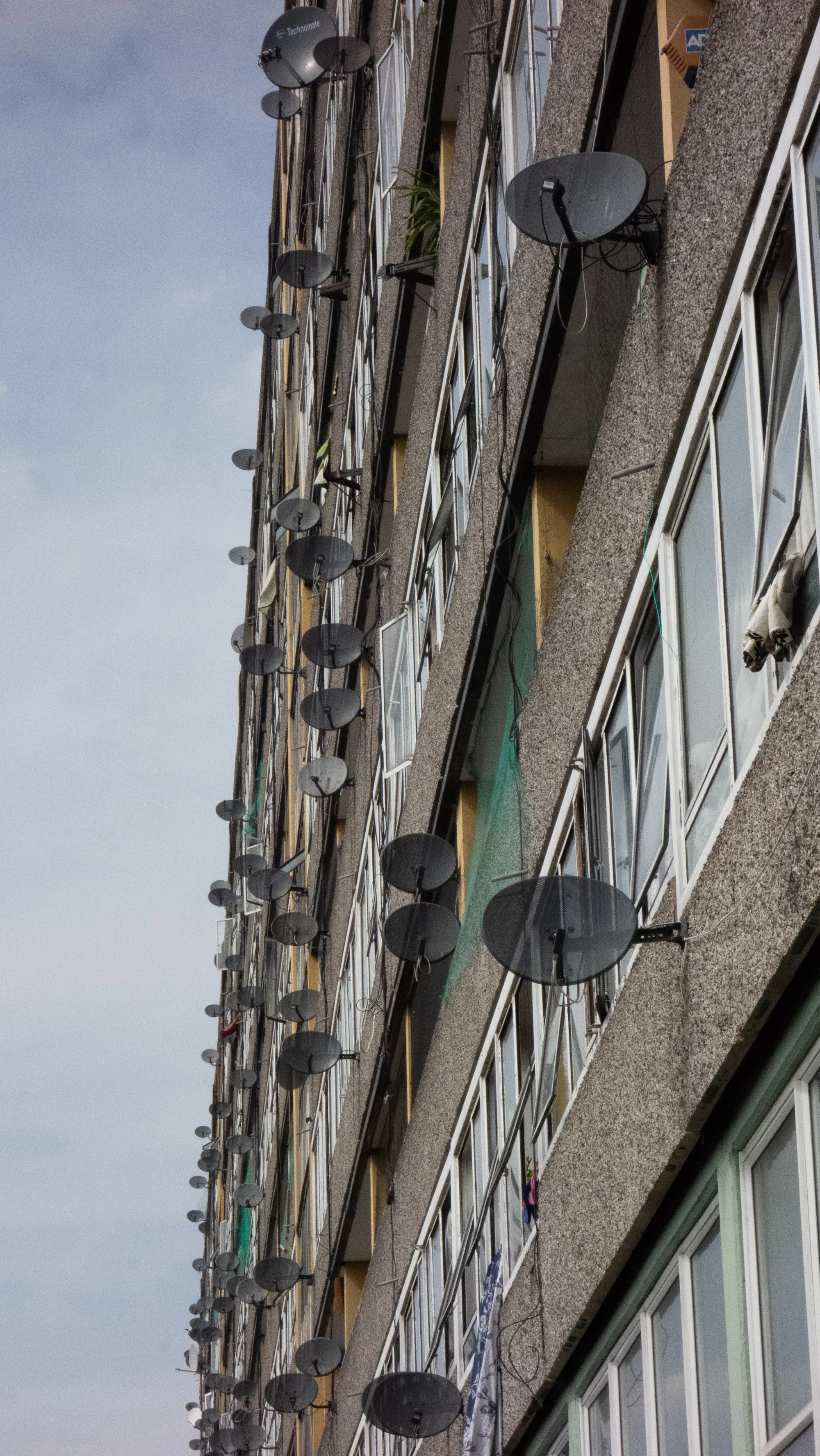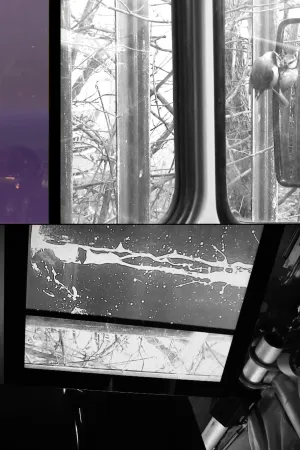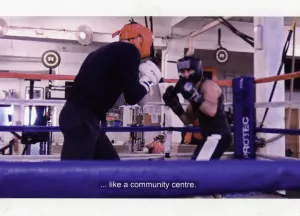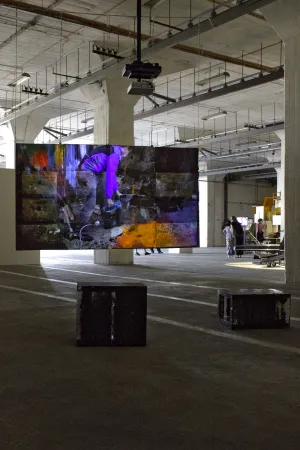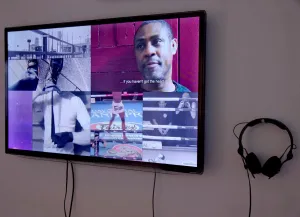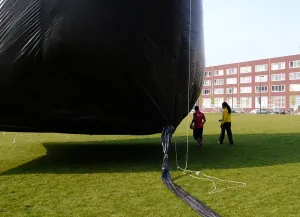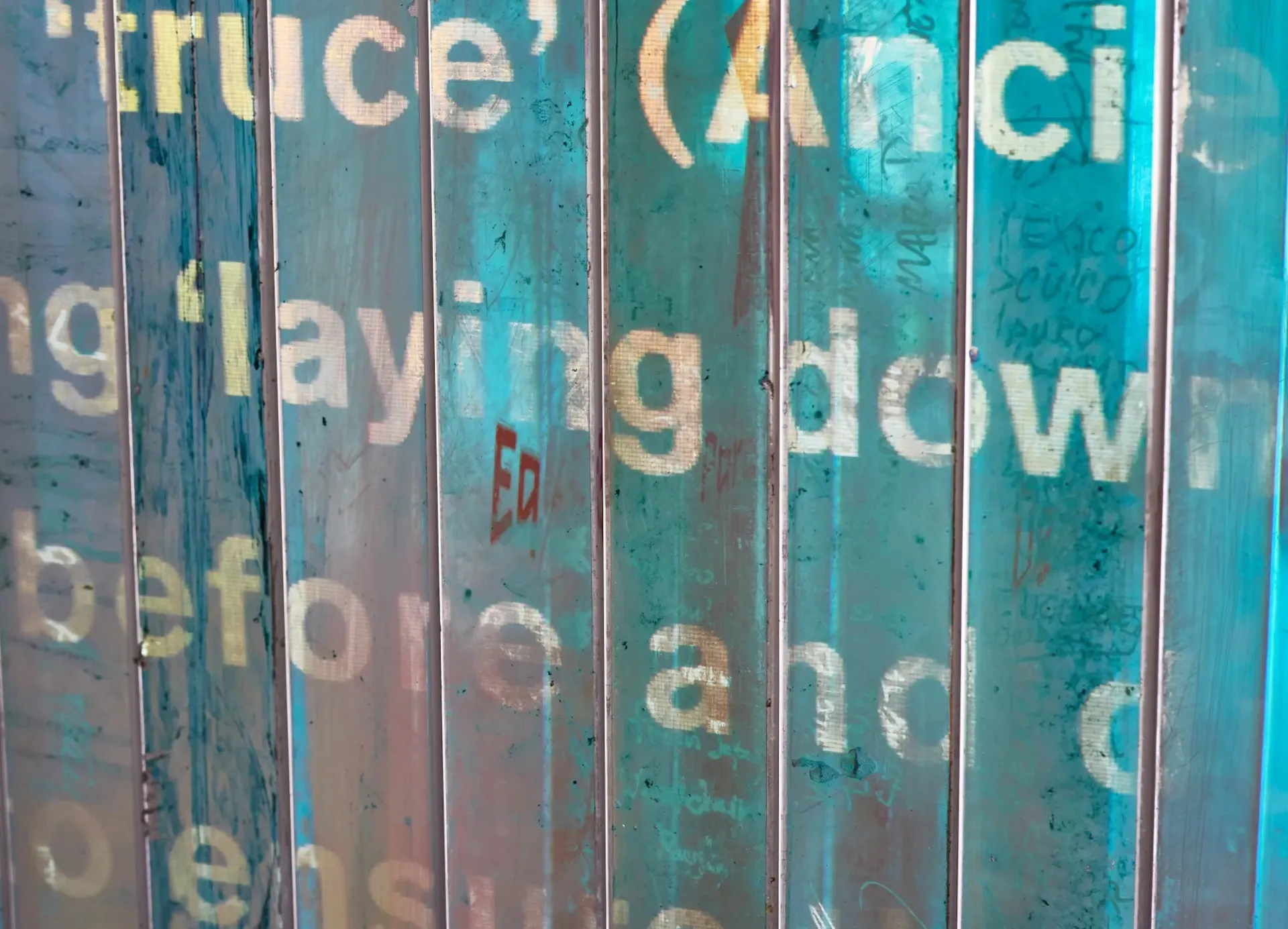
S P E C T R E
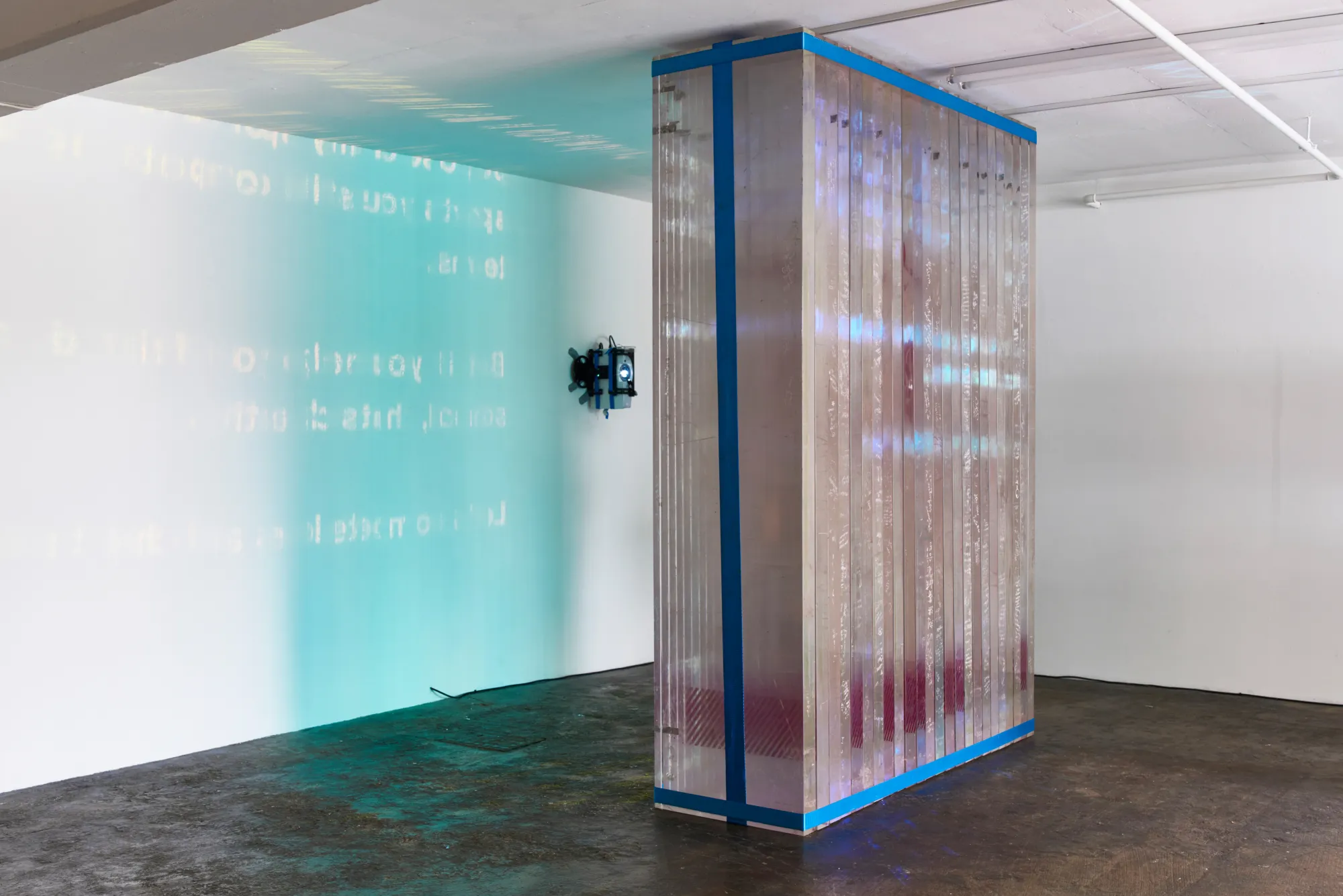
EN / SPECTRE, 2017.
London, UK
Installation: 24 signed sheets of acrylic Perspex, coated in dichroic film
Remnants of the original 2012 London Olympic Truce Wall, London
Blue ratchet straps
Dimensions: 1.80m × 2.50m × 0.58m
Video text: 4:34 min
SPECTRE consists of the remains of the original Olympic Truce Wall, designed by the London-based Mike Smith Studio for the 2012 Olympic Games. Although the studio is known for high-profile projects — including collaborations with Damien Hirst — the Olympic Truce Wall’s components were discarded after the Games: a telling symbol of the broken promises made to the residents of neighbouring London districts. While extensive funding for urban regeneration had been promised in the lead-up to the Olympics, much of it was never delivered. Even the proposed Olympic Museum, where the Truce Wall was to be permanently displayed, was never realized. Instead, large portions of the installation found their way to the Olympic Museum in Lausanne, Switzerland.
A friend of the artist, who builds adventure playgrounds in London, salvaged several panels of the Truce Wall before they were destroyed and stored them as building materials in his workshop. Inspired by the material and its symbolic weight, Daniel Vollmond developed the installation SPECTRE: the originally freestanding panels were tightly strapped together using blue ratchet straps, forming a massive, heavy block. In the exhibition space, a scrolling text was projected onto its surface, refracted through the dichroic coating and multiplied across the room in shimmering reflections.
The text was co-written by Daniel Vollmond and artist Alicja Rogalska. It explores the history of the transparent panels, their symbolic weight within the Olympic narrative, and the parallel reality of walls as barriers, tools of exclusion, and instruments of power. In SPECTRE, the very concept of competition - whether in sport or as a driving force in neoliberal societies — is critically examined. The work calls for a shift away from individualism and rivalry toward solidarity and collective responsibility.
EN / SPECTRE, 2017.
London, UK
Installation: 24 signierte Acrylglasplatten (Perspex), beschichtet mit dichroitischer Folie
Überreste der originalen Olympischen Friedensmauer der Spiele von London 2012
Blaue Spanngurte
Abmessungen: 1.80m × 2.50m × 0.58m
Videotext: 4:34 min
SPECTRE besteht aus den Überresten der originalen Olympischen Friedensmauer, die 2012 vom Londoner Mike Smith Studio für die Olympischen Spiele entworfen wurde. Obwohl das Studio für hochkarätige Projekte bekannt ist – unter anderem durch Arbeiten mit Damien Hirst – landeten die Elemente der Friedensmauer nach den Spielen im Müll: ein bezeichnendes Sinnbild für die gebrochenen Versprechen gegenüber den Bewohner:innen der angrenzenden Londoner Stadtteile. Denn im Zuge der Olympischen Spiele wurden umfassende Mittel zur Stadtentwicklung angekündigt, aber nie bereitgestellt. Auch das geplante Olympiamuseum, in dem die Friedensmauer dauerhaft ausgestellt werden sollte, wurde nie realisiert. Stattdessen gelangten große Teile der Installation in das Olympische Museum in Lausanne, Schweiz.
Ein Freund des Künstlers, der in London Abenteuerspielplätze baut, bewahrte einige Elemente der Friedensmauer vor der Entsorgung und lagerte sie als Baumaterial in seiner Werkstatt ein. Fasziniert von diesem Fund entwickelte Daniel Vollmond daraus die Installation SPECTRE: Die ursprünglich frei stehenden Stehlen wurden mit blauen Spanngurten zu einem massiven, tonnenschweren Block verzurrt. Im Ausstellungsraum wird ein Fließtext auf ihre Oberfläche projiziert, der sich durch die dichroitische Beschichtung des Materials bricht und in vielfachen Spiegelungen und Reflexionen den Raum erfüllt.
Den Text verfasste Daniel Vollmond gemeinsam mit seiner Künstlerkollegin Alicja Rogalska. Er thematisiert die Geschichte der transparenten Elemente, ihre symbolische Aufladung im olympischen Geistt und die gleichzeitige Realität von Wänden als Grenze, Ausschlussmechanismus und politisches Instrument. In SPECTRE wird die Idee des Wettbewerbs – im Sport ebenso wie im neoliberalen Gesellschaftsmodell – kritisch hinterfragt. Die Arbeit ruft dazu auf, Konkurrenzdenken zugunsten von Solidarität und kollektiver Verantwortung zu überwinden.
S P E C T R E
Installation View at ASC Gallery
EN / SPECTRE
2017 / London, UK
583 words
Reading time: 2.5 - 3min
The Olympic Truce is a tradition originating from Ancient Greece that dates back to the 8th century BC. A ‘truce’ (Ancient Greek: ékécheiria, meaning ‘laying down of arms’) was announced before and during the Olympic Games to ensure the host polis was not attacked and athletes and spectators could travel safely to the Games and peacefully return to their respective countries. The Olympic Truce was revived in 1992 by UN resolution 48/11 of 25 October 1993.
The idea is represented by the Olympic Truce Wall, which in 2012 was made from heavy sheets of acrylic perspex, measuring 250cm x 58cm x 7.5cm. Each sheet is coated in dichroic film, which causes visible light to be split up into distinct beams of different wavelengths (colours).
During the Olympic Games it was signed by athletes and important public figures, a symbolic gesture to transcend borders and differences in favour of a more equal and peaceful world. After the games it was meant to be displayed in the new Olympic Museum in London. However, this museum was never built and the wall was discarded.
In 2007 Tessa Jowell, the culture secretary and Olympics minister, announced a temporary diversion of a further £675 million of Lottery money from arts and charity funds toward the Olympic Games. The total budget for the 2012 Games exceeded £9bn. The diverted arts and charity funding totalling £2.2bn was never repaid.
In 2012, the International Olympic Committee president, the Archbishop of Canterbury and the mayor of London, Boris Johnson all signed the Truce Wall. And so did the Syrian delegation.
I once read an article in ‘The World Today’ (July 2016) about global leadership. It ended with the statement that ‘change is war’. Walls are there to prevent change from happening. I have seen many fragments of the Berlin Wall in various museums and other locations around the world. You can still buy pieces of it at Berlin Schönefeld airport at prices ranging from €4.95 a piece. Considering the actual wall was 155km long, it is possible that all these pieces are originals. Though I still have a suspicion that if all these fragments of the Berlin wall were put together, they would exceed the original in length.
Today, at least 65 walls or fences have been completed or are under construction between nations, four times as many as when the Berlin Wall was toppled.
Competition is one of the driving forces in Western Societies. Neoliberalism treats competition as the defining characteristic of human relations - it allows us to distinguish who and what is valuable and to create a hierarchy. Competition is also the most apparent purpose of any sport. Even if you do team sports you still compete against other teams. But if you help your friend in a test at school, that’s cheating. Let’s compete less and cheat more.
London, 15.09.2017.
DE / SPECTRE
2017 / London, UK
583 Wörter
Lesezeit: 2.5 - 3min
Der Olympische Friede ist eine Tradition aus dem antiken Griechenland, die bis ins 8. Jahrhundert v. Chr. zurückreicht. Vor und während der Olympischen Spiele wurde ein sogenannter Waffenstillstand (altgriechisch: ékécheiria, „Niederlegung der Waffen“) ausgerufen, um sicherzustellen, dass die gastgebende Polis nicht angegriffen wurde und Athlet:innen sowie Zuschauer:innen sicher zu den Spielen reisen und anschließend friedlich in ihre Heimat zurückkehren konnten. 1992 wurde die Tradition durch die UN-Resolution 48/11 vom 25. Oktober 1993 wiederbelebt.
Die Idee soll durch die Olympische Friendesmauer repräsentiert werden, die 2012 aus schweren Acrylglasplatten, mit Maßen von jeweils 250cm x 58cm x 7,5cm, gefertigt wurde. Jede Platte ist mit einer dichroitischen Folie beschichtet, die das sichtbare Licht in seine Spektralfarben bricht und so die Oberfläche je nach Blickwinkel in unterschiedlichen Farben erscheinen lässt.
Während der Spiele wurde die Wand von Athlet:innen und prominenten Persönlichkeiten unterzeichnet – ein symbolischer Akt, der nationale Grenzen und Differenzen überwinden und für eine gleichberechtigte, friedlichere Welt stehen soll. Nach den Olympischen Spielen war geplant, die Wand dauerhaft im Olympiamuseum in London auszustellen. Doch das Museum wurde nie realisiert – und die Wand schließlich entsorgt.
Im Jahr 2007 kündigte die damalige Kultur- und Olympiaministerin Tessa Jowell die vorübergehende Umleitung von 675 Millionen Pfund aus Lotteriegeldern, ursprünglich für Kunst- und Wohltätigkeitsprojekte vorgesehen, in das Budget der Olympischen Spiele an. Das Gesamtbudget der Spiele überschritt schließlich die Marke von 9 Milliarden Pfund. Insgesamt beliefen sich die umgeleiteten Mittel aus Fördergeldern für Kunst und gemeinnützige Zwecke auf 2,2 Milliarden Pfund – sie wurden nie zurückerstattet.
2012 unterzeichneten der Präsident des Internationalen Olympischen Komitees, der Erzbischof von Canterbury und Londons Bürgermeister Boris Johnson die Truce Wall, ebenso wie die offizielle Delegation aus Syrien.
Ich las einmal einen Artikel in The World Today (Juli 2016) über globale Führungsmodelle. Er endete mit dem Satz: „Veränderung ist Krieg.“ Mauern existieren, um Veränderung zu verhindern. Ich habe Fragmente der Berliner Mauer in Museen und an vielen Orten auf der Welt gesehen. Am Flughafen Berlin-Schönefeld kann man noch immer Stücke davon kaufen – ab 4,95 € pro Stück. Angesichts der ursprünglichen Länge der Mauer von 155 Kilometern ist es durchaus denkbar, dass viele dieser Stücke echt sind. Dennoch beschleicht mich der Verdacht, dass die Summe aller weltweit zirkulierenden Fragmente die ursprüngliche Länge übersteigt.
Heute existieren oder entstehen weltweit mindestens 65 Mauern oder Grenzzäune zwischen Staaten – viermal so viele wie zum Zeitpunkt des Mauerfalls.
Wettbewerb ist eine der zentralen Triebkräfte westlicher Gesellschaften. Der Neoliberalismus versteht ihn als grundlegendes Prinzip menschlicher Beziehungen: Er dient dazu, zwischen wertvoll und weniger wertvoll zu unterscheiden, Hierarchien zu etablieren – und sozialen Druck zu erzeugen. Auch im Sport ist Wettbewerb das offensichtlichste Ziel jeder Disziplin. Selbst Teamsportarten bedeuten letztlich Konkurrenz mit anderen Mannschaften. Doch wer einem Freund in der Schule bei einem Test hilft, gilt als jemand, der schummelt. Vielleicht sollten wir einfach weniger konkurrieren – und dafür mehr schummeln.
London, 15.09.2017.

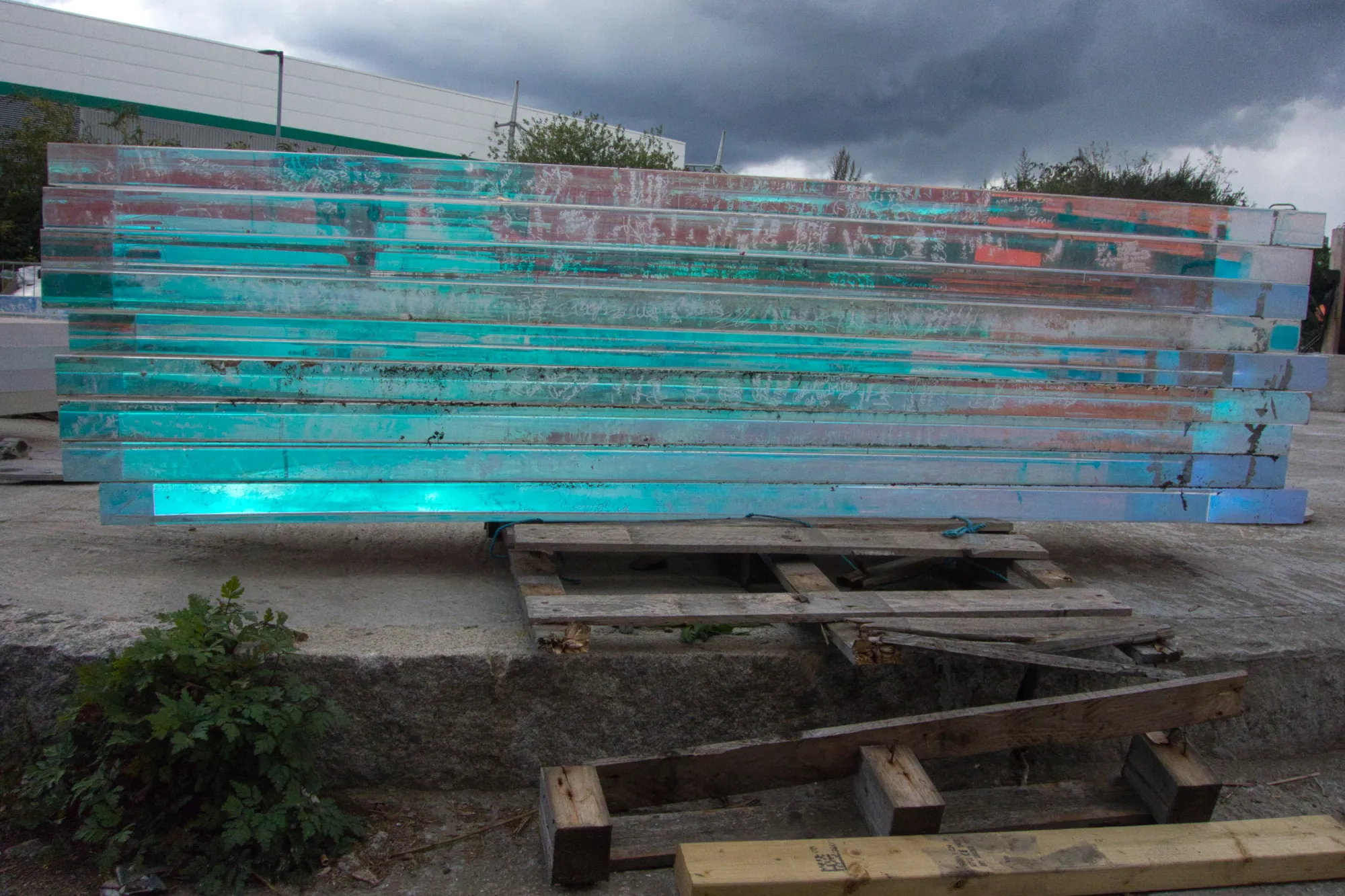
EN / The Olympic Truce Wall
Since the 9th Century BC a truce has been called for the Olympic Games, to allow safe travel to and from the event. In these modern times, the Truce Wall, or Peace Wall, as it is sometimes known, shows the commitment of the International Olympic Committee to inspire peace through sport. All athletes, trainers and staff taking part in the games are invited to sign their name or leave messages on the peace wall, to show their support for the Truce.
Each ‘totem’ was made by welding a large steel ‘clamp’ to hold each of the sheets of acrylic in place. This steel piece also held waterproof lights to illuminate the wall at night. They were fabricated and assembled at our workshop, and then transported to the Olympic Park to be lowered into place. The edges of the acrylic were coated in dichroic film, meaning the totems seemed to change colour as you moved around them. Each totem also bore a message or symbol of the games – many of them quotes by school children.
Between the Olympic and Paralympic games we removed the front and rear panel of each totem, to allow for the new Paralympic-branded messages and symbols to be installed, and proved the Paralympic athletes with a fresh surface to sign.
Mike Smith Studio
London, 2012.
DE / Die Olympische Friedenswand
Mike Smith Studio
London, 2012.
Seit dem 9. Jahrhundert v. Chr. wird im Rahmen der Olympischen Spiele ein Waffenstillstand ausgerufen, um allen Beteiligten eine sichere An- und Abreise zu ermöglichen. In der Gegenwart steht die sogenannte Waffenstillstandsmauer, auch Friedensmauer genannt, symbolisch für das Engagement des Internationalen Olympischen Komitees, den Frieden durch Sport zu fördern. Alle Athlet:innen, Trainer:innen und Mitarbeitenden, die an den Spielen teilnehmen, sind eingeladen, ihren Namen auf der Mauer zu hinterlassen, als Zeichen ihrer Unterstützung für die Idee des Waffenstillstands.
Jedes 'Totem' wurde durch das Schweißen einer großen Stahlklammer vervollständigt, die jede einzelne Acrylplatte an ihrem Platz hält. In jedes dieser Stahlelemente war zudem eine wetterfeste Leuchte integriert, mit der die Wand nachts beleuchtet wurde. Die Totems wurden in unserer Werkstatt gefertigt und vormontiert, anschließend in den Olympiapark transportiert und dort vor Ort installiert. Die Kanten der Acrylplatten wurden mit dichroitischer Folie beschichtet, sodass sich ihre Farbwirkung je nach Blickwinkel veränderte. Jedes Totem trug darüber hinaus eine Botschaft oder ein Symbol der Spiele – viele davon stammten aus Zitaten von Schulkindern.
Zwischen den Olympischen und Paralympischen Spielen wurden die Vorder- und Rückseiten der Totems erneuert, um Platz für neue Botschaften und Symbole der Paralympics zu schaffen. So erhielten auch die paralympischen Athlet:innen ihre eigene, frische Fläche für ihre Unterschriften.
Mike Smith Studio
London, 2012.
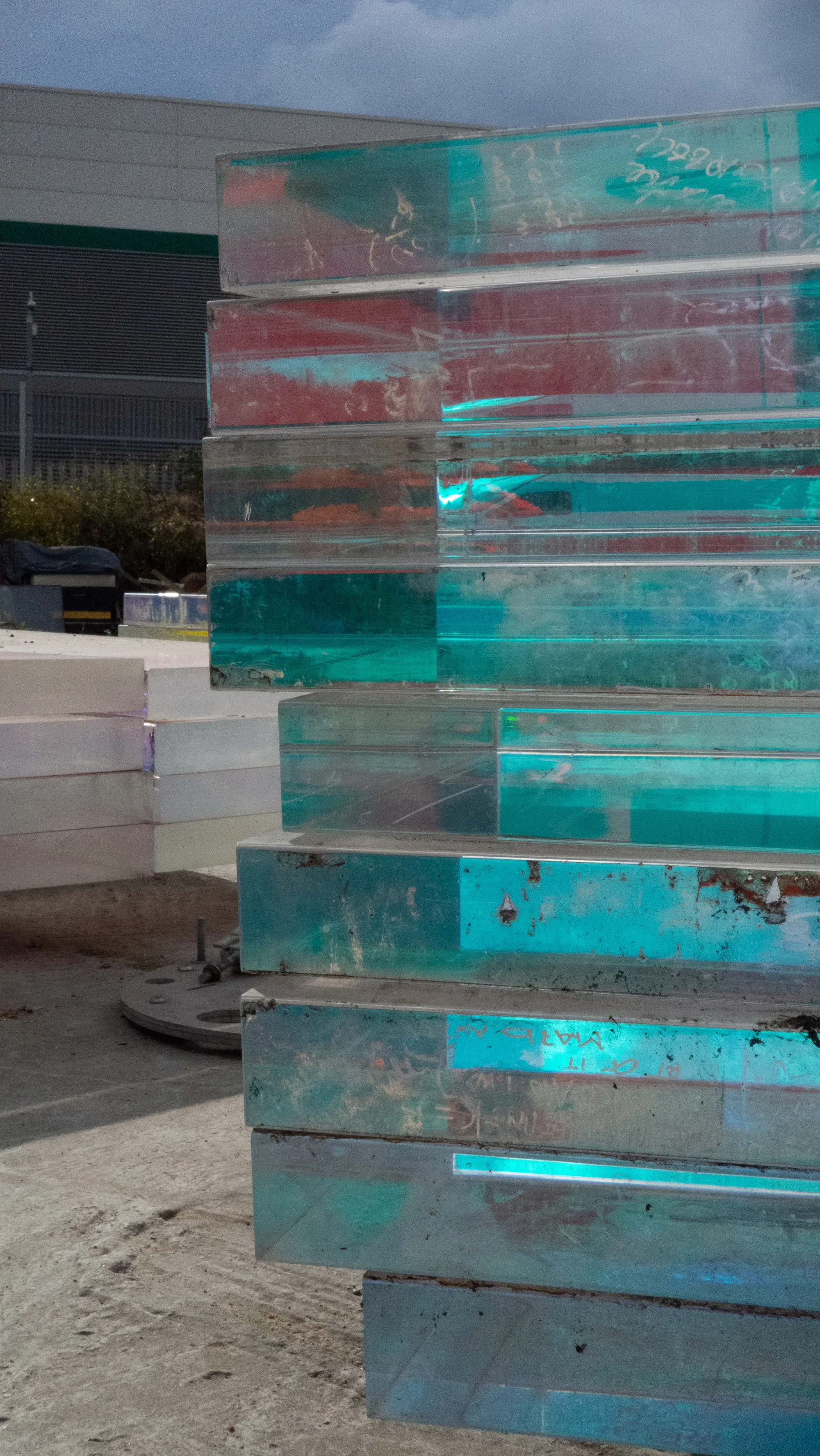
Future Refrains
18.09. - 27.10.2017, ASC Gallery, Elephant and Castle (UK)
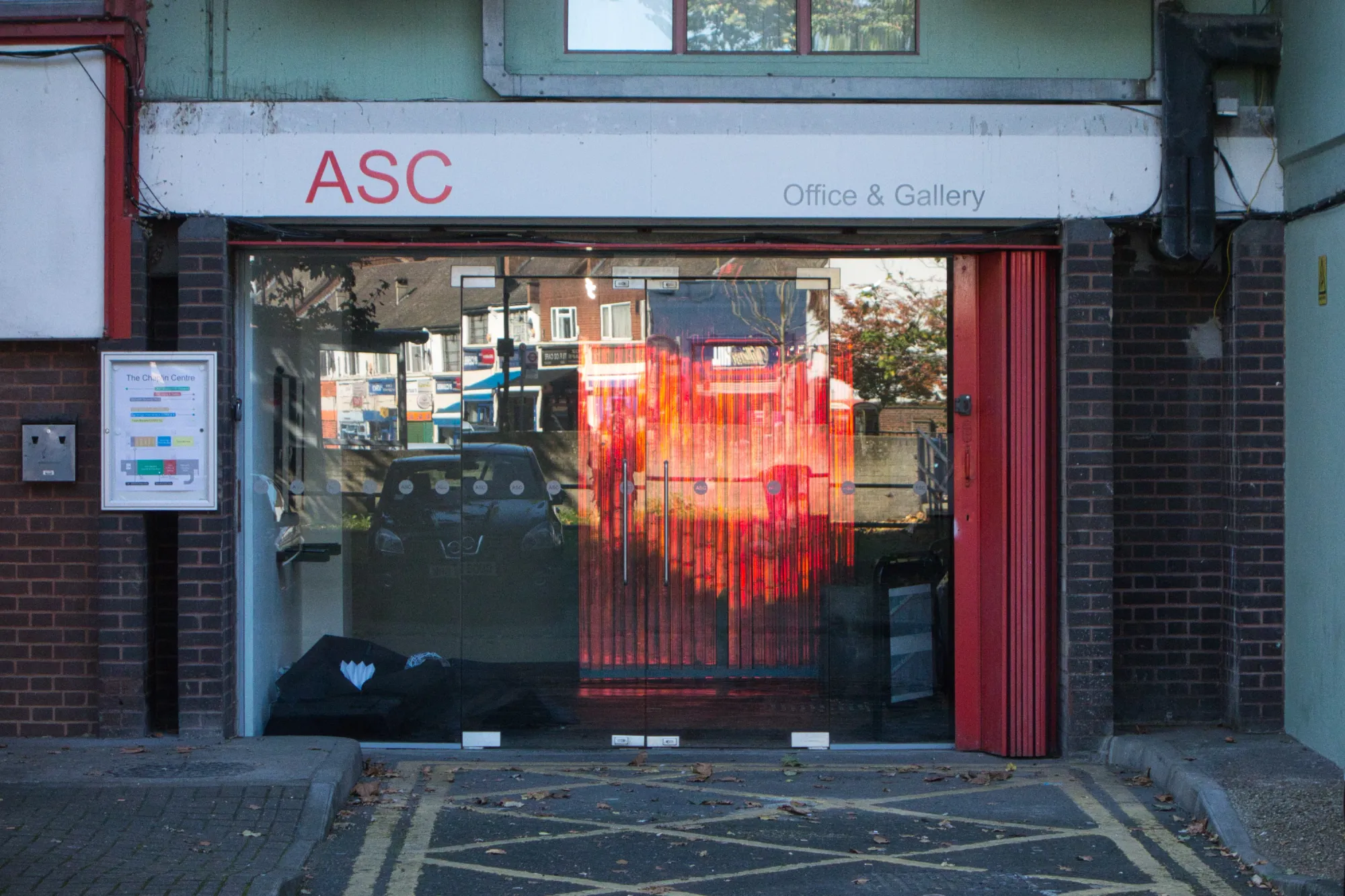
Future Refrains
An exhibition initiated by Peer Sessions
An exhibition to showcase collaborative practice
Participating Artists:
Alicja Rogalska chose to work with Daniel Vollmond
Anita Delaney chose to work with Simon Gerrard
James Ferris chose to work with Paula Linke
With additional new work by: Adam Chodzko and Lindsay Seers
ASC Gallery / The Chaplin Centre
Taplow House, Thurlow Street
London SE17 2DG
United Kingdom

